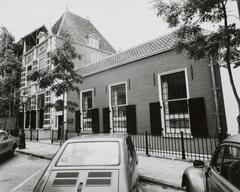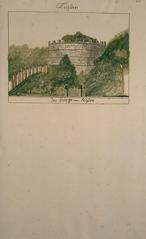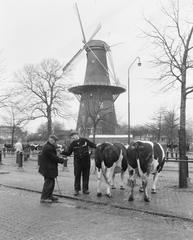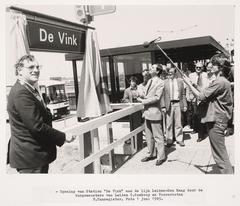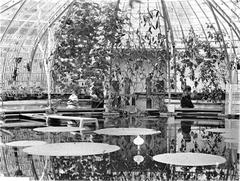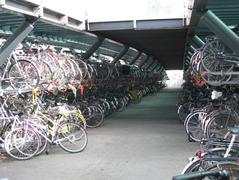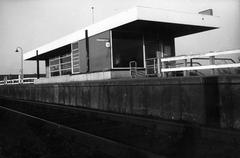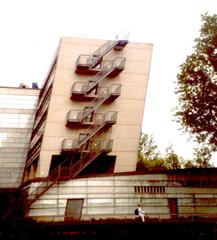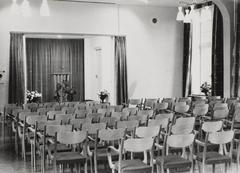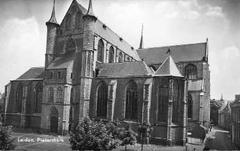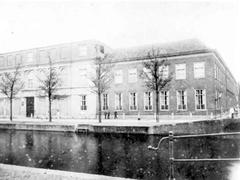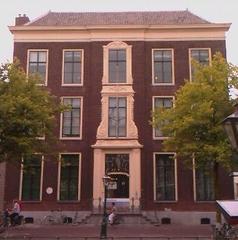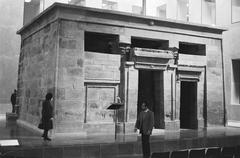Sumatrabrug: Visiting Hours, Tickets, and Complete Guide to Leiden’s Historic Bridge
Date: 04/07/2025
Introduction
Sumatrabrug is a distinctive green-painted drawbridge in Leiden, Netherlands, gracefully spanning the Oude Rijn and connecting the neighborhoods of De Waard and De Kooi. More than a practical crossing, it is a living symbol of Leiden’s layered history, blending its colonial connections, academic heritage, and urban development. As part of the city’s extensive network of over 88 bridges and 28 kilometers of canals, Sumatrabrug exemplifies how infrastructure, history, and culture intersect in one of the Netherlands’ most picturesque cities (Leiden Holland; Facts.net: Leiden).
This guide provides an in-depth overview of Sumatrabrug, including its historical significance, architectural features, visiting hours, accessibility, and practical tips for making the most of your visit. Whether you’re a history enthusiast, photographer, or urban explorer, Sumatrabrug offers a unique window into Leiden’s past and present.
Table of Contents
- Origins and Naming of Sumatrabrug
- Sumatrabrug and Leiden’s Colonial Heritage
- Urban Development and the Role of Bridges
- Architectural Features and Evolution
- Visiting Sumatrabrug: Hours, Tickets, and Access
- How to Get There
- Nearby Attractions
- Events and Festivals
- Photography and Scenic Value
- Visitor Tips and Practical Information
- FAQs
- Conclusion and Call to Action
- Sources and Further Reading
Origins and Naming of Sumatrabrug
Sumatrabrug, translating to “Sumatra Bridge,” reflects Leiden’s tradition of naming infrastructure after Dutch colonial territories, especially the Indonesian island of Sumatra. This convention, prominent in the late 19th and early 20th centuries, commemorates the Netherlands’ far-reaching maritime and colonial history (Leiden Holland). The bridge is part of a neighborhood where streets and bridges are named after Indonesian islands, a subtle yet enduring reminder of Leiden’s global connections.
Sumatrabrug and Leiden’s Colonial Heritage
Leiden’s role as a center for colonial administration and scholarship is deeply intertwined with Sumatrabrug’s history. Leiden University, the oldest in the Netherlands, was pivotal in training civil servants for the Dutch East Indies and fostering research on Asian and colonial studies (Facts.net: Leiden; Leiden University: Colonial and Global History). The economic importance of Sumatra—particularly for oil and plantations—further cemented the city’s links to the colony (Gale: European Colonialism in the Early 20th Century).
Sumatrabrug thus serves both as a literal and symbolic bridge, connecting generations to the layered narratives of Leiden’s colonial past and its ongoing engagement with global history.
Urban Development and the Role of Bridges
Leiden’s “City of Canals and Bridges” reputation is well-earned, with Sumatrabrug playing a vital role in facilitating movement across waterways that once defined the city’s trade and defense (Facts.net: Leiden; townsofeurope.com). The expansion of bridges like Sumatrabrug in the late 19th and early 20th centuries reflected Leiden’s economic revival and the growth of its student population (Leiden Holland). These bridges enabled the city’s transformation from a fortified medieval town into a vibrant modern urban center.
Architectural Features and Evolution
Sumatrabrug is a classic Dutch bascule bridge, a movable structure using counterweights to allow boat passage. Its superstructure—typically steel—permits a slender design with unobstructed canal views. The bridge features non-slip decking, gentle ramps for accessibility, and railings in traditional dark hues (exploreleiden.nl; Visit Leiden). Discreet lighting highlights its form at night, and its modest scale ensures harmony with the historic streetscape.
Sumatrabrug undergoes regular maintenance to ensure structural integrity, including recent electrical system updates (A-Quin). Preservation efforts focus on maintaining its original character while upgrading safety features.
Visiting Sumatrabrug: Hours, Tickets, and Access
Opening Hours: Sumatrabrug is a public bridge, open 24/7 year-round. There are no entrance fees or tickets required to visit or cross the bridge (Wikipedia; Waterkaart.net).
Bridge Operation: As a drawbridge, it opens several times daily (especially in spring and summer) to allow boat traffic. Openings typically last 5–10 minutes. The schedule can be checked on Waterkaart.net.
Accessibility: The bridge is fully accessible to pedestrians, cyclists, wheelchairs, and strollers, featuring smooth, gently sloped approaches and non-slip surfaces.
Crossing Etiquette: Always observe traffic lights and barriers; never cross during bridge openings. Cyclists should yield to pedestrians, and all users are encouraged to share the space respectfully.
How to Get There
Sumatrabrug is centrally located at the extension of Sumatrastraat and Admiraalsweg. It’s easily reached:
- By Foot/Bike: About a 10-minute walk or a short bike ride from Leiden Centraal Station.
- Public Transport: Several local buses stop nearby.
- By Car: Limited street parking is available, but public transport or cycling is recommended due to city center restrictions (explorecity.life).
For precise directions, use navigation apps or search “Sumatrabrug, Leiden.”
Nearby Attractions
Sumatrabrug’s location provides easy access to:
- Leiden’s Historic Center: Explore canals, museums, and markets (Tourist Places Guide).
- Burcht van Leiden: A medieval fortification offering panoramic city views.
- National Museum of Ethnology: A leading museum on world cultures.
- Hortus Botanicus: One of the world’s oldest botanical gardens (explorecity.life).
- Museum De Lakenhal: Showcasing Leiden’s artistic heritage including Rembrandt’s works.
- De Valk Windmill Museum and the Haarlemmerstraat shopping district (thecrazytourist.com).
Many canal boat tours pass under Sumatrabrug, offering unique photo opportunities (DutchReview).
Events and Festivals
Sumatrabrug is integral to Leiden’s major festivals:
- Leidens Ontzet (October 3rd): The bridge is decorated and serves as a key passage for city-wide celebrations (explorecity.life).
- Stadsfestival de Lakenfeesten (July): Music, parades, and the famous Dragonboat Races animate the canals and bridges (visitleiden.nl).
During these times, the bridge becomes a vibrant community hub and a prime viewing spot for festivities.
Photography and Scenic Value
Sumatrabrug is beloved by photographers for its classic Dutch design and vibrant green color. Recommended photo spots:
- On the bridge: Capture panoramic canal views and historic facades.
- From the banks: Best at sunrise or sunset for warm light and reflections.
- During bridge openings: Dynamic shots of the movable span.
Early mornings and late afternoons are ideal for both tranquility and optimal lighting.
Visitor Tips and Practical Information
- Best Times to Visit: Spring and summer for lively boat traffic; autumn and winter for quiet ambiance.
- Safety: Always obey bridge signals and supervise children. The surface can be slippery when wet.
- Local Etiquette: Keep right on the bridge, yield to faster cyclists, and avoid lingering during rush hours.
- Facilities: No public restrooms at the bridge; use nearby cafés in the city center.
- Sustainability: Dispose of waste responsibly and use eco-friendly transport.
FAQs
Q: Are there any entrance fees or tickets required to visit Sumatrabrug?
A: No, the bridge is free and open 24/7.
Q: Is Sumatrabrug wheelchair accessible?
A: Yes, the bridge has gently sloped approaches and smooth surfaces.
Q: When does the bridge open for boats?
A: Several times daily, more frequently in spring and summer. Check Waterkaart.net for schedules.
Q: Are guided tours available?
A: Many walking and canal tours include Sumatrabrug as a highlight (Visit Leiden).
Q: How do I reach Sumatrabrug from Leiden Centraal Station?
A: It’s about a 10-minute walk or a short bike ride, well signposted.
Conclusion and Call to Action
Sumatrabrug is more than a functional crossing—it is a living monument to Leiden’s rich history and contemporary vibrancy. Its role as a connector—between neighborhoods, between past and present—makes it an essential stop for anyone exploring the city. With its accessible design, scenic views, and proximity to major attractions and events, Sumatrabrug invites you to experience Leiden’s unique blend of heritage and modern life.
For the latest updates, event information, and self-guided tours, download the Audiala app, follow Leiden’s official tourism channels, and consult the resources below.
Sources and Further Reading
- Leiden Holland
- Gale: European Colonialism in the Early 20th Century
- Facts.net: Leiden
- Visit Leiden
- Leiden University: Colonial and Global History
- Wikipedia: Sumatrabrug
- Waterkaart.net: Sumatrabrug
- ExploreLeiden.nl: Discover Leiden on Foot
- Towns of Europe: Leiden, Netherlands
- SoloSophie: Visit Leiden Guide
- Holland Beyond: Leiden
- ExploreCity.life: Leiden
- The Crazy Tourist: Best Things to do in Leiden
- Audiala app
